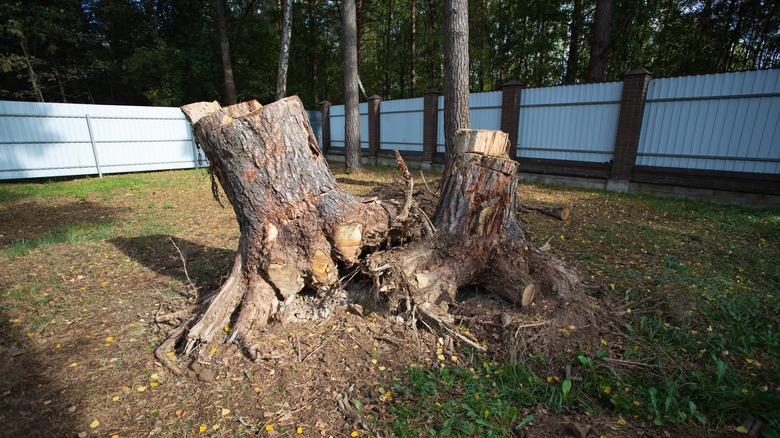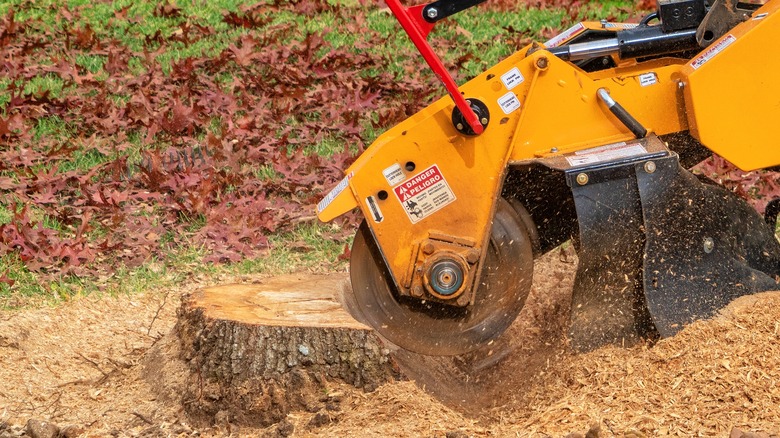A tree stump in your garden can be annoying. However, it doesn’t have to be a permanent fixture. Luckily, there’s more than one way to get rid of it, whether you’re thinking of using machinery or leaning towards chemicals for a more subtle approach. But let’s break down what you’re actually dealing with here. Stumps pop up in our gardens for all sorts of reasons. Maybe a storm knocked a tree down, disease claimed a green giant, or you decided it was time for a change and chopped it down yourself. But that stump sitting there is just the beginning of the story. Underneath, there’s a whole network of roots that have made themselves quite cozy deep in the ground.
And let’s be real, stumps are more than just unsightly. They’re like little landmines of inconvenience in your garden tripping people up, hogging space, and even inviting pests to come over and act like they own the place. It might feel like getting rid of one is something you need to call in the professionals for. But here’s some good news — armed with the right information, some basic tools, and a healthy dose of patience, this is a battle you can win on your own. Before you charge in, there are a few things to consider when removing a tree stump. Think about how big that stump is, the extent of its root system, and what tools you’ve got in your arsenal. Tackling a stump is not just about brute force; it’s about being smart and safe about it.
Chemical removal: a less labor-intensive method

If you’re dreading the backbreaking work of yanking a tree stump out of the ground the old-fashioned way, the best way is to use chemicals. This method gives that stubborn stump a gentle nudge to break down on its own, saving you from sweat and sore muscles. First things first – you need to gear up with a few items: a trusty drill, a wide drill bit, some chemical stump remover (potassium nitrate is the go-to), water, and a tarp or plastic sheeting. And don’t forget to protect yourself with gloves and safety glasses — you want to keep those splashes at bay. Start by drilling deep holes across the top of the stump, keeping them a few inches apart. Then, fill those holes with the chemical stump remover, and don’t forget to follow the directions on the package. Sometimes, you’ll need to add water to get the solution just right. Next up, cover the stump with a tarp or plastic to keep the moisture in, which is crucial for breaking down the wood.
Now, patience is your virtue. This chemical breakdown dance takes time, ranging from a few weeks to just over a month. This may depend on the size of your stump and what kind of wood you’re dealing with. Eventually, the stump will get soft and spongy, and that’s your cue. With minimal effort, you can now break it apart and clear the space, and maybe even with a bonus sense of accomplishment for not having to wrestle it out of the ground.
Manual method: a hands-on approach

If you’re ready to roll up your sleeves and tackle the stump head-on, the manual route is perfect, especially for those smaller stumps. You’re going to need a shovel or a mattock for the digging part, an ax or saw for those stubborn roots, and maybe a winch if the stump’s putting up a real fight. And don’t forget about protecting yourself. Gloves, boots, and eye protection are non-negotiables here. First, take your shovel or mattock and start digging around the stump to expose the network of roots underneath. You’ll want to clear enough space around the stump to work comfortably. Next, it’s time to deal with the upper roots. With them now in plain sight, grab your ax or saw and start cutting them away from the stump. Be prepared for a bit of a workout here, especially if the roots are thick and tough. The real challenge often lies with the taproot — the main root that anchors the tree firmly in the ground. Digging around this root and then cutting or prying it loose can be demanding. If the stump proves particularly resilient, employing a winch to haul it out might be your best option.
While the manual method offers immediate satisfaction and tangible results, it’s not without its demands, requiring a good deal of physical effort and the right tools for the job. In contrast, chemical removal is a more hands-off approach, though it lacks the immediacy of manual labor.



